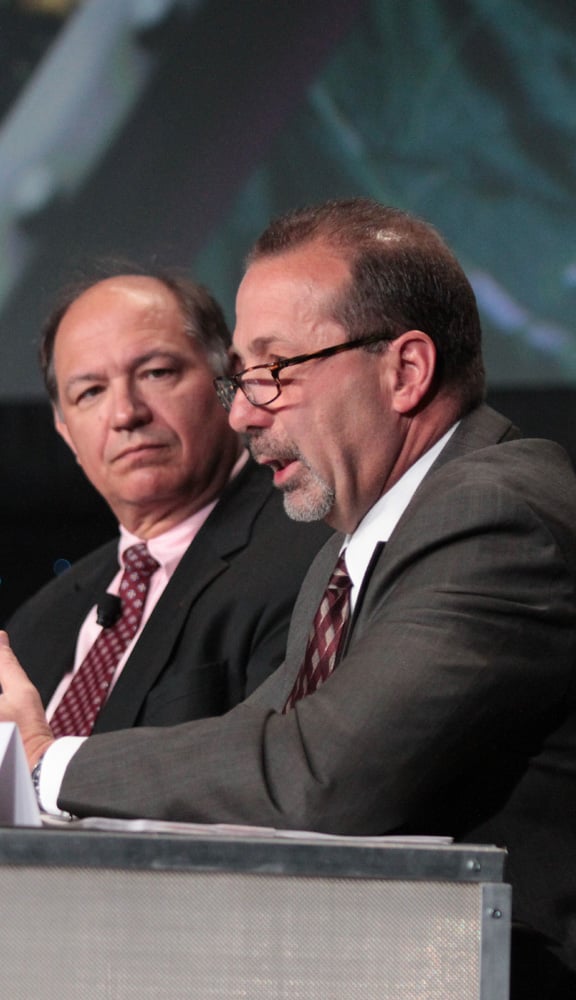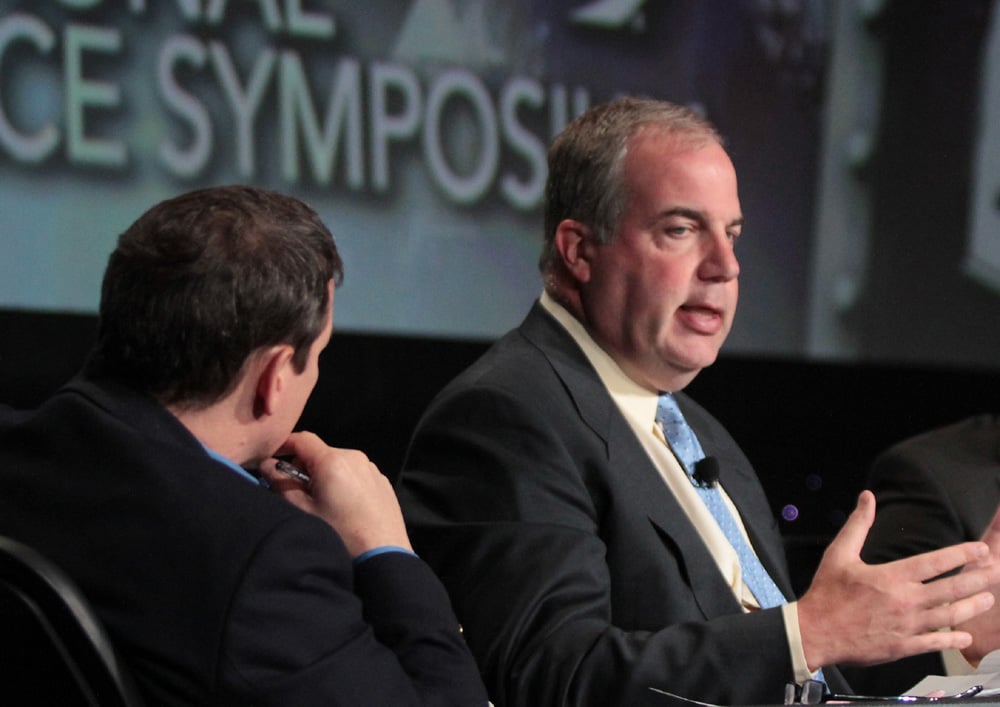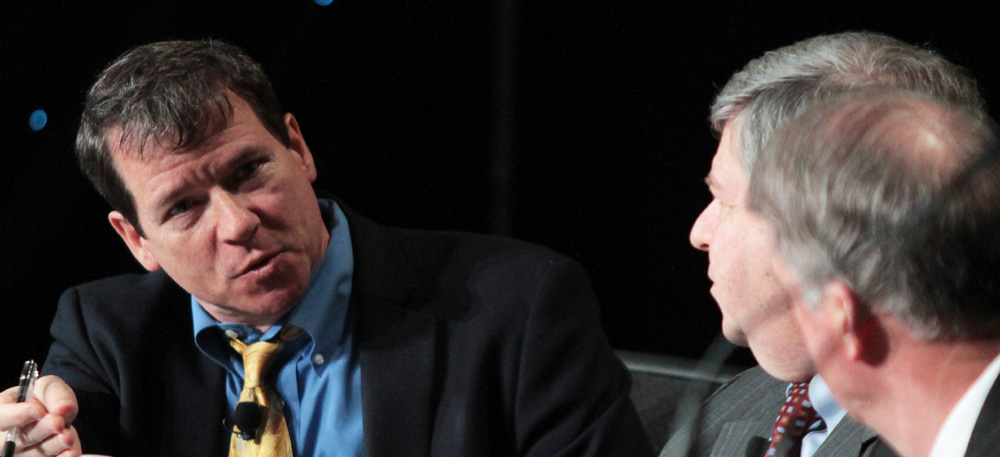Space Symposium
Satellite Operators, Manufacturers Discuss Issues, Needs
Written by: developer
Two satellite industry panels were held during the 28th National Space Symposium on Wednesday morning, April 18. Both were hosted by Space News Editor Warren Ferster.
Satellite Operators & Manufacturers - Part 1

Part I covered:
David Bernstein, senior vice president - program management, Space Systems/Loral (pictured, above, second from left): The commercial satellite business is solid and the marketplace looks good for moderate growth. Even though sequestration won't directly affect the commercial business, it will affect suppliers, which will have an impact. ITAR is a daily issue that we've learned to deal with; it's just a part of doing business. But, we'd love to see it changed and satellites moved back to commerce. As a commercial contractor, we are on our own for R&D, so we plough our own profits back in for innovation, improvements and development.
Jeffrey D. Grant, sector vice president and general manager - space systems, Northrop Grumman Aerospace Systems (pictured, above, left): The market looks flat over next few years; we are dealing with this by focusing on affordability and manufacturing efficiencies. There is potential damage of sequestration to the satellite manufacturing industry - the process of slowing, stopping and restarting can be very damaging. As advanced AEHF enters the production phase and there are fewer new projects, we risk losing skilled R&D employees. Currently, we are dealing with it by assigning them to adjacencies, but long term, this could be an issue. Consolidation makes more efficient use of limited resources.
 Maj. Gen. Craig Cooning, USAF, Ret., vice president and general manager, Boeing Space and Intelligence Systems (pictured, above, center): We are making up for decline in defense business with increases in commercial business, including hosted payloads. No one wants sequestration, but we believe that sanity will creep back into the process. WGS is more aligned with the commercial marketplace, which has made the program less expensive and more robust. Industry needs to work hard to pull down the recurring cost of satellites to create headroom for more R&D. We think the administration is moving in the right direction with ITAR reform.
Maj. Gen. Craig Cooning, USAF, Ret., vice president and general manager, Boeing Space and Intelligence Systems (pictured, above, center): We are making up for decline in defense business with increases in commercial business, including hosted payloads. No one wants sequestration, but we believe that sanity will creep back into the process. WGS is more aligned with the commercial marketplace, which has made the program less expensive and more robust. Industry needs to work hard to pull down the recurring cost of satellites to create headroom for more R&D. We think the administration is moving in the right direction with ITAR reform.
Frederick J. Doyle, Jr., vice president and corporate lead executive for the defense and intelligence community, Ball Aerospace & Technologies Corp. (pictured, above, second from right): We're trying to make the sequestration issue "very personal," by addressing potential jobs lost. Ball made a concerted effort to get close to customers who have research dollars, so we are engaged with many research organizations and serve as a transition partner. There is always a risk that the small will be eaten by the big, but we like to look at it as "the fast will eat the slow."
Mark Valerio, vice president and general manager - surveillance and navigation, Lockheed Martin Space Systems (pictured, above, right): A diverse portfolio helps to level the work and revenue; our focus is also affordability and efficiency. GPS affords an opportunity to produce a large number of satellites, which will create economies of scale and a better supply base. The Air Force's back-to-basics approach has created a few upfront issues because suppliers haven't wanted to supply parts for testing, but the upfront testing will pay huge dividends. We now insert capability when it is ready; in the past we have had issues when we have tried to introduce technology before it's ready. Current environment is similar to the 90s, which would indicate that there will be industry consolidations.
See video here.
Satellite Operators & Manufacturers - Part 2
The satellite industry has become such an important part of the space industry and there are so many companies involved that the 28th National Space Symposium fielded two panels on Wednesday morning, April 18, to discuss issues and opportunities. The Satellite Operators and Manufacturers Part 2 panel took up where the Part I panel left off.

Key points included:
Andrew Sukawaty, chairman, Inmarsat (pictured, above, right): Drawdown in Afghanistan has softened demand, but that comes with territory. Business is dependent on events, and when the next event comes, we want to be ready to put capability in place. Long-term demand trends will be present in multiple bands, but timing is critical from a commercial perspective. The more Wideband Global Satellite (WGS) there is, the more disruption there is on the commercial side. But, with the ramp-up of demand, it shouldn't be too much of an issue. When making investments, we consider spectrum availability; there is a lot of availability in KA and KU; L is more limited; both play critical roles. We would like to see more government predictability, but since we sell on demand, we are less affected by changes in policy.
Kay Sears, president, Intelsat General (pictured, above, second from right): The Iraq drawdown was modest, but surprisingly fast. As soon as capacity returns to the fleet, it gets redeployed to meet other demand; so, we'll continue to see capacity spread out across a broader field. The WGS system will be a very sophisticated system and, over time, we may see a tempering of demand for commercial capability. The diversity and flexibility of commercial satellite services will continue to be desired by the military even when it has its own systems. Specifically in the area of intelligence, surveillance and reconnaissance, companies need a clear idea of what commercial satellite providers can do in this area, and all frequencies need to be leveraged to this end. The commercial sector is serving the government UAV market well, which begs the question of why would we go to the expense to transfer UAVs to the KA band. We need to leverage all frequencies rather than allocate government to just government bands.
 Brig. Gen. Robert (Tip) Osterthaler, USAF, Ret., president and chief executive officer, SES Government Solutions (pictured, above, left): There's a lot of uncertainty in the department of defense about what will happen in Afghanistan and when, which is driving caution in contracting. WGS is coming online and, because it is free to users, it is very attractive. It is a special challenge because it will create disruptions through greater bandwidth demand. We would like to see more deliberate and rigorous analysis of cost because when the government competes with commercial entities there is rarely an apples-to-apples comparison; I don't think we know the real capability cost of WGS. The rhetoric of partnership from the government is not the same as binding business partnerships. They present significant risks; it's a serious problem. Regarding budget constraints, in the future when we are more constrained, we will need a more rigorous analysis of cost. Government needs to deal with industry in a way that allows companies to make investments.
Brig. Gen. Robert (Tip) Osterthaler, USAF, Ret., president and chief executive officer, SES Government Solutions (pictured, above, left): There's a lot of uncertainty in the department of defense about what will happen in Afghanistan and when, which is driving caution in contracting. WGS is coming online and, because it is free to users, it is very attractive. It is a special challenge because it will create disruptions through greater bandwidth demand. We would like to see more deliberate and rigorous analysis of cost because when the government competes with commercial entities there is rarely an apples-to-apples comparison; I don't think we know the real capability cost of WGS. The rhetoric of partnership from the government is not the same as binding business partnerships. They present significant risks; it's a serious problem. Regarding budget constraints, in the future when we are more constrained, we will need a more rigorous analysis of cost. Government needs to deal with industry in a way that allows companies to make investments.
Matthew Desch, chief executive officer, Iridium Communications, Inc. (pictured, above, second from left): Diversification to meet customer needs keeps the business stable. When working with the DoD, we are often in a back-up role, but now that we are moving to expeditionary missions, we play a larger role. Companies that work in different bands are starting to work together. We try not to work in commoditized markets; rather it's about partnering and being flexible. Understanding the environment isn't easy for customers, including government, but the industry does benefit from predictability. While opportunistic industry/government relationships can have positives outcomes, more benefit could come from putting a broader plan in place to institutionalize such partnerships.
Samer Halawi, chief executive officer, Thuraya (pictured, above, center): Three factors are important - troop withdrawal, demand shifts to other areas and budget tightening. That makes it a good match for small, on-demand satellites with fixed-fee packages. We believe customers are looking for solutions that are not restricted to a specific band. We should meet demand rather than adding capacity just to add capacity. The commercial sector brings innovation, which is badly needed.
 The panel was moderated by Space News Editor Warren Ferster (pictured, right).
The panel was moderated by Space News Editor Warren Ferster (pictured, right).
See photos here. See video here.
This article is part of Space Watch: June 2012 (Volume: 11, Issue: 6).


